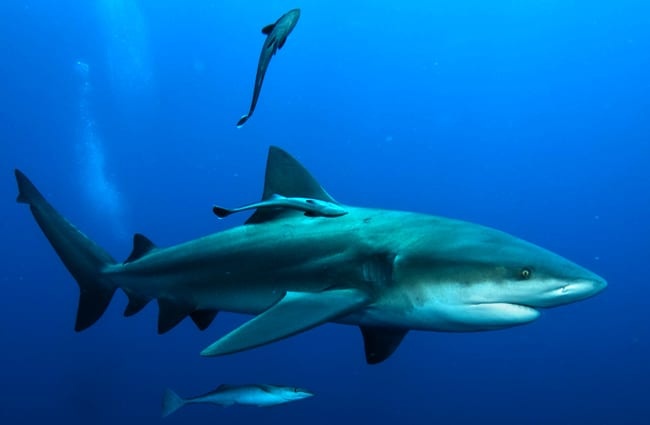Bull sharks are a notoriously aggressive species of shark native to shallow coastal waters in warm regions. They are also capable of moving into brackish water systems, where salt and freshwater mix.
People have also found them in fresh water, but this is less common. This species is responsible for many shoreline shark bites, including some of those blamed on other species. Read on to learn about the bull shark.
Description of the Bull Shark
This species of shark is large and stout, and the females are even larger than the males. They are around 8 feet long on average, and the largest recorded individual was just over 13 feet long.
Their coloration provides camouflage, as they are grey on top and white on their undersides. This makes them difficult to see from both above and below. Compared to other sharks, they have relatively short snouts, and low tail fins.
Interesting Facts About the Bull Shark
Before you jump straight to fearing bull sharks, it is important to understand their behavior. These sharks aren’t simply mindless killing machines. They are interesting creatures, and you should learn more about them below.
- Freshwater Swimmers – Despite the fact that they can swim in freshwater environments, bull sharks are not freshwater sharks. They are one of the few species that live primarily in saltwater, but can also venture into freshwater.
- Bull Sharks and Humans – This shark species is very likely to run into humans from time to time. They like to feed in shallow, murky waters and this makes them more likely to encounter humans at beaches or in rivers.
- Why Bite – Shark bites do not always occur because a shark is trying to eat someone. Bull sharks are territorial, and this is the primary reason that they are more likely to bite humans. Their territories overlap with areas where humans commonly sunbathe.
- Jaws – When you picture the shark from the movie Jaws, it’s likely that you picture a great white shark. In reality, a number of shark bites along the Jersey Shore in 1916 inspired Jaws. Because some of these bites happened in freshwater and brackish water, scientists believe a bull shark, or multiple bull sharks, were responsible.
Habitat of the Bull Shark
These sharks prefer hunting in shallow waters that are close to the coast. Most bull sharks reside in waters less than 100 ft. deep. They live in warm waters, and can travel from the ocean into rivers and lakes.
There are even constant populations in a number of major rivers, including the Mississippi River, the Brisbane River, the Amazon River, and more. After storms and flooding it is common to find bull sharks in inland lakes and rivers they might not normally be able to access.
Distribution of the Bull Shark
This species lives along shallow coastlines in warm areas of the world. They are somewhat cosmopolitan, and populations reside across much of the earth in warm regions. On the west coast of the Americas they range from Baja California to Ecuador.
In the western Pacific Ocean they reside from the coast of the northern United States all the way to Brazil. They also range along the coasts of Africa, parts of India, Australia, and a number of islands in the eastern Pacific.
Diet of the Bull Shark
While they will eat a wide variety of prey, their primary food source is fish, sharks, and stingrays. Like most shark species, they are opportunistic, and feed on just about anything that they can safely eat.
They will cannibalize smaller bull sharks when given the opportunity. Other, less common prey species include turtles, crabs, birds, land mammals, and marine mammals. Most hunt alone, but researchers have spotted bull sharks hunting in packs on occasion.
Bull Shark and Human Interaction
As discussed above, bull sharks do frequent many of the same areas that humans do. Because of this, they are responsible for large numbers of shark bites. They hunt in murky water, so it is difficult to see them approaching. Despite this, it is incredibly unlikely you will be the victim of a shark bite. In fact, you are more likely to have a vending machine fall on you!
Sadly, humans often victimize sharks because of this fear. They also capture them for sport and commercial fisheries. In addition to deliberate capture, fishermen accidentally catch bull sharks while fishing for other species. Capture for shark fin soup is a primary cause of the population decline of this species. Because of these factors, the IUCN lists bull sharks as Near Threatened.
Domestication
Humans have not domesticated bull sharks in any way.
Does the Bull Shark Make a Good Pet
No, bull sharks do not make good pets. It would be incredibly difficult to keep them in a home aquarium, primarily because you would need an incredibly large tank. They are also quite dangerous and aggressive.
Bull Shark Care
There are a number of aquariums that house bull sharks across the world. Depending on the aquarium, the success of keeping these sharks in captivity varies. In some places, bull sharks in aquariums can live upwards of 20 or 25 years.
As is the case with any large species of shark, you must house bull sharks in huge tanks with plenty of swimming space. They will feed on just about anything, so getting them to eat is not difficult.
Behavior of the Bull Shark
These sharks are usually solitary, but they sometimes feed as a group. They are territorial, and can be quite aggressive towards humans, other sharks, and virtually anything that roams too close. Most hunting occurs at dawn and dusk, and they use the cloudy waters to hide their approach. Most prey does not know the shark is there until the shark taken a bite.
Reproduction of the Bull Shark
This species breeds during summer and early fall, and usually travels into brackish or fresh water to reproduce. They have a year long gestation, and give birth to live young. Female sharks give birth to up to 13 young sharks, called pups.
They travel to shallow, sheltered waters, like river mouths and estuaries, to give birth. The pups are fully independent at birth, and remain in protected waters until the grow large enough to defend themselves.











![Red Angus Closeup of a beautiful Red Angus cowPhoto by: U.S. Department of Agriculture [pubic domain]https://creativecommons.org/licenses/by/2.0/](https://animals.net/wp-content/uploads/2020/03/Red-Angus-4-238x178.jpg)












![Red Angus Closeup of a beautiful Red Angus cowPhoto by: U.S. Department of Agriculture [pubic domain]https://creativecommons.org/licenses/by/2.0/](https://animals.net/wp-content/uploads/2020/03/Red-Angus-4-100x75.jpg)

